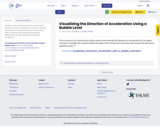
Using a projectile launcher, students determine the relationship between launch height and launch range.
- Subject:
- Force/Motion/Energy
- Science
- Material Type:
- Activity/Lab
- Date Added:
- 12/14/2019

Resources to support the Science Standards of Learning - Physics

Using a projectile launcher, students determine the relationship between launch height and launch range.

Students use metersticks and spring scales to analyze the force required to pull and lift two different masses. Analysis questions then direct students to think about a force exerted through a displacement, and the companion document can then be used to spark classroom discussion. This is not meant to be an all-inclusive document; further discussion will be required to properly introduce Work and Energy.

Using classroom materials, students construct and then perform a lab to determine whether two different types of bulbs are ohmic. Students use the document as lab guidance. The teacher can decide what level of formality is required in the lab writeup.

Video Description: In this close-up video, Jessica Taylor, Physical Scientist at NASA's Langley Research Center, describes her role in developing and bringing NASA Earth Science data to the public, educators, and learners in fun and engaging ways. She shares how her love of meteorology and, in particular, lightning sparked her interest in becoming a scientist and set her career path. She also shares the joy she finds in family-centered activities like swimming and dancing. You can also engage in NASA Earth Science with projects like My NASA Data and the GLOBE Program. Video Length: 2:30.NASA eClips Ask SME: Close-up with a NASA Subject Matter Expert videos are professionally developed to capture a glimpse of NASA SME's personal interests and career journeys. Each can be used to spark student interest and broaden their ideas of the STEM workforce. Additional videos in this series can be found by searching GoOpenVA using "NASA eClips Ask SME".

Video Description: In this close-up video, Dr. Nicholeen Viall, Research Astrophysicist at NASA's Goddard Space Flight Center, shares her love for astronomy and ballet and how her creativity has helped her ask questions about the sun that no one has ever asked before. Video Length: 2:20.NASA eClipsTM is a suite of online student-centered, standards-based resources that support instruction by increasing STEM literacy in formal and nonformal settings. These free digital and downloadable resources inform and engage students through NASA-inspired, real-world connections.NASA eClips Ask SME: Close-up with a NASA Subject Matter Expert videos are professionally developed to capture a glimpse of NASA SME's personal interests and career journeys. Each can be used to spark student interest and broaden their ideas of the STEM workforce. Additional videos in this series can be found by searching GoOpenVA using "NASA eClips Ask SME".

Video Description: Engineering design and technology development support scientific discovery. Learn about the roles engineers and scientists play when working together on NASA missions like the James Webb Space Telescope and how science and engineering take turns pushing each other to move exploration forward. Video Length: 4:16.NASA eClipsTM is a suite of online student-centered, standards-based resources that support instruction by increasing STEM literacy in formal and nonformal settings. These free digital and downloadable resources inform and engage students through NASA-inspired, real-world connections.NASA eClips Launchpad videos focus on NASA innovations and the technology that take us into the future. These segments support project-based and problem-based learning experiences in science, mathematics, and career and technical education classrooms.

Science Instructional Plans (SIPs) help teachers align instruction with the Science Standards of Learning (SOL) by providing examples of how the content and the scientific and engineering practices found in the SOL and curriculum framework can be presented to students in the classroom.

Students will download and view a video of a ball traveling with projectile motion. Students will analyze the video to determine the ball's launch angle and launch velocity following the ball's first bounce.

Here is a simple lab report that can be used in any science class (6-12). The report is designed to help students identify hypotheses, independent and dependent variables, controls, constants, and to analyze experiments. I have also included tips on a simple way to teach your students to identify the IV and DV through a "cave man hypothesis" and how to teach controls with less confusion.

Science Instructional Plans (SIPs) help teachers align instruction with the Science Standards of Learning (SOL) by providing examples of how the content and the scientific and engineering practices found in the SOL and curriculum framework can be presented to students in the classroom.

Students use the companion document as a standalone activity to develop a mathematical model for determining the wavelength of light using a diffraction grating.

Students use a bubble level and a cart that can undergo constant acceleration in order to visualize the direction of acceleration for an accelerating object. Students then reverse the process to differentiate between positive and negative acceleration.